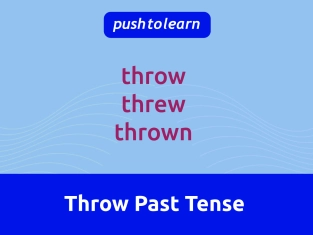by PushtoLearn
Shine Past Tense
Table of Contents
Shine Past Forms - Exercises
These exercises test different forms of the verb SHINE and IRREGULAR VERBS
Meaning
The verb "shine" means to emit light or reflect light brightly. It can also be used figuratively to indicate excellence or brilliance.
Example:
-
"The sun shines brightly in the sky."
-
"She shines in every performance she gives."
When referring to past actions, "shine" has two forms depending on the context:
-
"Shone" is used when referring to emitting light.
-
"Shined" is used when referring to polishing or bringing something to a reflective state.

Forms of "Shine"
|
Tense |
Form |
Example Sentence |
|
Present |
shine |
"The stars shine brightly at night." |
|
Past (light context) |
shone |
"The moon shone over the quiet lake." |
|
Past (polish context) |
shined |
"He shined his shoes before the interview." |
|
Past Participle |
shone/shined |
"The lamp has shone for hours." / "She has shined the silverware." |
|
Present Participle |
shining |
"The lamp is shining on the desk." |
Examples of "Shine" in Sentences
Past Tense (shone or shined):
1. Referring to emitting light (shone):
-
"The lighthouse shone brightly across the water."
-
"Her eyes shone with excitement when she saw the surprise."
-
"The lamp shone through the fog."
2. Referring to polishing or improving (shined):
-
"He shined the car until it gleamed."
-
"She shined her jewelry for the big event."
-
"They shined the floors to make them look new again."
Past Participle (shone or shined):
1. Referring to emitting light (shone):
-
"The stars have shone brilliantly all night."
-
"The sun had shone on the flowers, making them bloom."
-
"The lantern has shone in the dark cave for hours."
2. Referring to polishing or improving (shined):
-
"He has shined his boots perfectly for the ceremony."
-
"The trophy had been shined before being presented."
-
"She has shined the countertops to a sparkling finish."
Common Mistakes with "Shine"
1. Using "shined" instead of "shone" for light contexts:
When describing light, "shone" is the correct past tense.
-
Incorrect: "The moon shined over the water."
-
Correct: "The moon shone over the water."
2. Using "shone" instead of "shined" for polishing contexts:
When describing the act of polishing, "shined" is correct.
-
Incorrect: "He shone his shoes before the meeting."
-
Correct: "He shined his shoes before the meeting."
3. Mixing up "shine" and "shiny" as adjectives:
"Shiny" is the adjective form, not a verb.
-
Incorrect: "The table was shine after cleaning."
-
Correct: "The table was shiny after cleaning."
Mastering irregular verbs is a must for the Past Simple — use this lesson to practice more. Check out other Grammar Exercises A1 for extra quizzes. Some irregular verbs you should know are Wind, Dive, and Fly.
FAQ
What is the past tense of "shine"?
The past tense of "shine" is "shone" for emitting light and "shined" for polishing.
How do I use "shone" in a sentence?
Use "shone" when referring to light:
Example: "The candle shone brightly in the dark room."
How do I use "shined" in a sentence?
Use "shined" when referring to polishing or making something reflective:
Example: "He shined his car before the show."
Can "shined" and "shone" be used interchangeably?
No, they are context-specific. Use "shone" for light and "shined" for polishing.
Can "shine" be used figuratively?
Yes! Example: "She shone during the competition," meaning she performed brilliantly or stood out.

